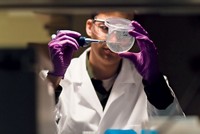Advertisement
Grab your lab coat. Let's get started
Welcome!
Welcome!
Create an account below to get 6 C&EN articles per month, receive newsletters and more - all free.
It seems this is your first time logging in online. Please enter the following information to continue.
As an ACS member you automatically get access to this site. All we need is few more details to create your reading experience.
Not you? Sign in with a different account.
Not you? Sign in with a different account.
ERROR 1
ERROR 1
ERROR 2
ERROR 2
ERROR 2
ERROR 2
ERROR 2
Password and Confirm password must match.
If you have an ACS member number, please enter it here so we can link this account to your membership. (optional)
ERROR 2
ACS values your privacy. By submitting your information, you are gaining access to C&EN and subscribing to our weekly newsletter. We use the information you provide to make your reading experience better, and we will never sell your data to third party members.
Drug Discovery
Covid-19
Is drug repurposing worth the effort?
What the pandemic has shown us about how to redeploy our pharmaceutical arsenal
by Bethany Halford
January 25, 2021
| A version of this story appeared in
Volume 99, Issue 3

When SARS-CoV-2 began to spread around the globe in early 2020, doctors and scientists reached for every drug they could think of to fight the coronavirus and its deadly symptoms. Soon, hundreds of clinical trials had sprung up to test everything from aspirin to Zithromax in the hope that drugs from our vast pharmaceutical arsenal might be successfully repurposed in the fight against COVID-19.
Drug repurposing involves taking an existing drug or drug candidate and using it for a medical condition that’s different from what it was originally developed to treat. The most well-known example is Viagra, which was originally conceived by Pfizer to treat hypertension and angina. The compound’s promise for treating erectile dysfunction emerged during clinical trials.
Support nonprofit science journalism
C&EN has made this story and all of its coverage of the coronavirus epidemic freely available during the outbreak to keep the public informed. To support us:
Donate Join Subscribe
That discovery was made serendipitously in the clinic. But about 20 years ago, scientists reasoned that they could conduct screenings in cells of vast libraries of approved drugs and molecules that had some clinical data to see if they might work for other indications. If any compounds looked promising in those tests, they could jump straight into clinical trials because companies already had enough data on their safety. The strategy eliminates most of the risks that come from developing a drug from scratch and dramatically speeds up the timeline to get a drug into people. At least that’s the idea.
As hospitals in China, then Europe and the US, became overwhelmed and the death toll rose in the spring of 2020, it made sense for doctors and scientists to open the medicine cabinet to try to find anything that might help—even if the effects were modest. Doctors started trying drugs known to dampen the body’s immune response in other diseases, like cancer and autoimmune disorders. In tandem, scientists began screening large libraries of drugs to see if they could kill the virus. Screening efforts sprang up at pharmaceutical companies, the US National Institutes of Health’s National Center for Advancing Translational Sciences (NCATS), and nonprofits like Calibr.
The results of those efforts have been largely underwhelming.
While several drugs received emergency use authorizations by the US Food and Drug Administration, just one drug—Gilead Sciences’ antiviral remdesivir, sold under the brand name Veklury—has been approved globally to treat COVID-19. But even that one repurposing success story comes with caveats. Remdesivir’s approval was based on a Phase 3 study run by the National Institute of Allergy and Infectious Diseases, which concluded that the drug shortens recovery time for hospitalized COVID-19 patients by a few days. Yet interim results from a World Health Organization study suggest that remdesivir has no benefits.
Regardless, remdesivir didn’t come from a large screening effort of existing drugs, which many consider the starting point for drug repurposing. Rather, doctors and scientists tried it because it was designed to shut down RNA-dependent RNA polymerases, an enzyme found in many viruses, including SARS-CoV-2. Remdesivir was originally developed to treat hepatitis C and later went through a clinical trial during the 2016 Ebola outbreak, where it failed to show any efficacy. Animal tests had shown it could treat coronaviruses, such as the one that causes MERS (Middle East respiratory syndrome).
“It was the obvious thing to test,” says Kara Carter, president of the International Society for Antiviral Research (ISAR). “One of the reasons we were able to move it forward so rapidly was because it had clinical data from its trials with Ebola.”
Doctors have also successfully used the corticosteroid dexamethasone to treat patients with COVID-19. But some argue that this isn’t drug repurposing. Doctors are using dexamethasone for its original purpose: to fight inflammation and an overactive immune system, two COVID-19 complications.
To date, all cases of successful drug repurposing for any disease have come from either the observations of astute clinicians or a deep understanding of drugs’ mechanisms of action, says Aled Edwards, founder and CEO of the Structural Genomics Consortium, a nonprofit that supports drug discovery efforts. Edwards says no large-scale laboratory screening effort has found an old drug that has been approved for a new indication. And he argues that the odds of finding a successful COVID-19 drug from such efforts is essentially nil.
“It’s not impossible, so it’s not a dumb idea to check just in case,” Edwards says. “But don’t bet your government’s COVID strategy on it.”
Derek Lowe, a pharmaceutical chemist who writes the popular In the Pipeline blog, agrees. “I think you have to try it because your barrier to entry is low, and if you do find something, you can go directly into patients. There’s nothing else that has that short a turnaround,” he says. “At the same time, that’s balanced out by the odds being really, really low that anything is going to actually work.”
Carter at ISAR says no one expects repurposing screens to identify more than a few useful drugs for any particular indication. Even so, she says, “repurposed efforts always need to be deployed when you have the emergence of a new disease, because if there is something that’s readily addressable to the population, you absolutely want to identify it rapidly and take it forward.”
Carter acknowledges that it has “taken a little bit longer than we were hoping to get some potent and approved agents in place for COVID-19.” But what people don’t appreciate, she adds, is that doctors and scientists didn’t understand the disease in the early days of the pandemic and are still working to fully grasp how it works and all its effects. “Trying to develop therapeutics while at the same time trying to understand the disease itself is challenging,” she says.
It’s tough to get a firm figure on the cost of efforts to repurpose drugs for COVID-19. Doing laboratory screens is relatively inexpensive, says Arnab Chatterjee, vice president of medicinal chemistry at Calibr, the drug development division of Scripps Research. Calibr is home to the ReFRAME collection, a 12,000-compound library established in 2018 with the goal of repurposing drugs. Scientists have been searching the collection hoping to find a COVID-19 antiviral. Chatterjee says that it cost about $20 million to build the ReFRAME collection. Developing a preclinical candidate from scratch usually costs tens of millions more than that.
“Drug repurposing in my mind is a worthwhile investment to at least see if there is something that could be used quickly, which in a pandemic we need to be able to do,” Chatterjee says. If we define drug repurposing as successful only if it produces an approved therapeutic, he says, “that is a very high bar.”
Chatterjee acknowledges that drug repurposing has not produced a surefire direct-acting antiviral that works against COVID-19. But, he says, repurposing efforts have taught us a lot about the disease.
For example, scientists now know that hepatitis C drugs don’t work broadly against COVID-19, even though that class of compounds can inhibit viral RNA-dependent RNA polymerases. “Repurposing from a class of molecules—a mechanistic-based approach—has been very challenging,” Chatterjee says. Instead, screening large libraries of compounds is more likely to yield a drug that can be repurposed because of off-target effects, he adds.
Even if screening efforts are relatively inexpensive, doing clinical trials of approved drugs is not. Lowe, the chemist and blogger, points out that the advantage of drug repurposing is that scientists have already done the early stages of clinical development, so the drugs can go straight to human studies. “The bad part,” he says, “is that you skipped all the cheap and easy stages and you have to go right into human clinical trials and spend all the money.”
More than 500 drugs have been or are still being tested in thousands of COVID-19 clinical trials worldwide, according to ClinicalTrials.gov. Most have been outright failures, and some, such as hydroxychloroquine, an antimalarial compound that former president Donald J. Trump touted as an effective COVID-19 treatment, may have actually been harmful. What’s more, experts say the scattershot approach of these efforts has wasted money, time, and valuable resources.
“When you look at the number of registered clinical trials directed toward coronavirus therapies, it’s way too many,” Lowe says. “A lot of these are junk.”
“We’ve tested a lot of things that, with less urgency, would have never gone into clinical trials,” says Matthew Hall, NCATS’s acting director of biology and group leader of the Early Translation Branch. Hall leads the center’s drug repurposing screening efforts.
A lot of those trials are vying for the same patients, ISAR’s Carter notes. Trials often don’t recruit enough people to get good data, or multiple trials on the same drug are going on concurrently. Carter says it would help if there were some mechanism for prioritizing resources for trials that focus on candidates with the best probabilities of success.
Hall says it’s important to think long term about both drug repurposing efforts and new antiviral development. “All the clinical trial candidates we’ve got—and there are so many of them—preexisted COVID,” he says. To be better prepared for the next pandemic, he says, it’s important to bolster our collection of available antivirals and to understand their activity against different virus classes. “Any new drugs we develop now are just the next pandemic’s new repurposing opportunity,” Hall says.





Join the conversation
Contact the reporter
Submit a Letter to the Editor for publication
Engage with us on Twitter